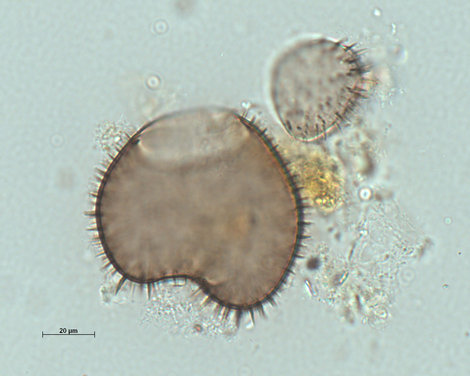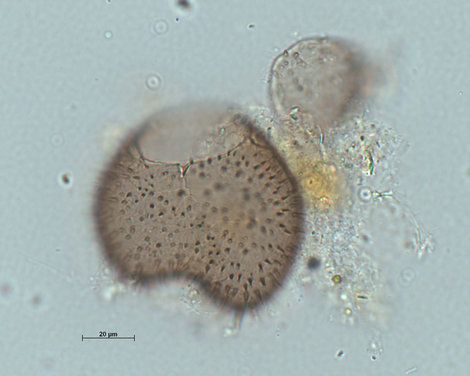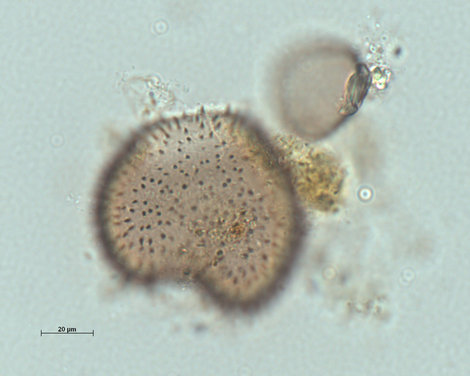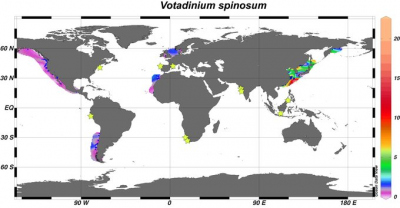Page path:
Votadinium spinosum
Zonneveld, K.A.F. and Pospelova V. (2015). A determination key for modern dinoflagellate cysts. Palynology 39 (3), 387- 407.

cross section
photo: Karin Zonneveld
photo: Karin Zonneveld

dorsal view
photo: Karin Zonneveld
photo: Karin Zonneveld

ventral view
photo: Karin Zonneveld
photo: Karin Zonneveld
Field Characteristics
Votadinium spinosum Reid 1977
Characteristics:
Cyst "heartshaped", with two rounded antapical horns that are separated by a shallow depression in dorsal view and with a rounded apex. Compressed dorso-ventrally to half the width of the cyst body giving a lunulate to hour glass outline in apical view. Wall thin with a smooth surface and ornamented by short solid spines which can be usually curved. Archeopyle intercalary 2a.
Motile affinity: Protoperidinium claudicans (Paulsen 1907) Balech 1974.
Cyst theca relationship: Wall and Dale, 1968
Comparison with other species:
This cyst can’t be missed since it is the only hearth shaped cyst with spines. Nice for a valentine card.
Characteristics:
Cyst "heartshaped", with two rounded antapical horns that are separated by a shallow depression in dorsal view and with a rounded apex. Compressed dorso-ventrally to half the width of the cyst body giving a lunulate to hour glass outline in apical view. Wall thin with a smooth surface and ornamented by short solid spines which can be usually curved. Archeopyle intercalary 2a.
Motile affinity: Protoperidinium claudicans (Paulsen 1907) Balech 1974.
Cyst theca relationship: Wall and Dale, 1968
Comparison with other species:
This cyst can’t be missed since it is the only hearth shaped cyst with spines. Nice for a valentine card.
Geographic Distribution
Geographic distribution based on :
Zonneveld et al., 2013. Atlas of modern dinoflagellate cyst distribution based on 2405 datapoints. Review of Palaeobotany and Palynology, v. 191, 1-197
Zonneveld et al., 2013. Atlas of modern dinoflagellate cyst distribution based on 2405 datapoints. Review of Palaeobotany and Palynology, v. 191, 1-197
Votadinium spinosum is a coastal temperate to tropical species which distribution is restricted to full-marine environments. Highest relative abundances occur in eutrophic environments (including upwelling areas) where bottom waters can be hypoxic to well ventilated. Cyst production may be increased by anthropogenic pollution, especially Nitrate. Furthermore a positive relationship between cyst production and diatom abundance can be observed in some regions.

Distribution:
Votadinium spinosum is restricted to coastal sediments from temperate to tropical regions where full marine conditions prevail. Highest abundances (up to 18%) occur in the East China Sea.
Environmental parameter range:
SST: are 0.7 - 29.4°C (winter - summer) with summer SST > 9.0°C. SSS: 25.5 - 37.7 (spring - autumn), [P]: 0.09 - 1.62 μmol/l, [N]: 0.3 - 18.4 μmol/l, chlorophyll-a: 0.13 - 19.99 ml/l, bottom water [O2]: 0.2 - 7.8 ml/l.
Votadinium spinosum is not observed in regions where hypersaline conditions occur throughout the year. It is abundant in mesotrophic and eutrophic environments with highest relative abundances in eutrophic settings.
Comparison with other records:
Apart from the recordings in this Atlas Votadinium spinosum has been observed in coastal sediments off India (Godhe et al., 2000; D'Costa et al., 2008), coastal bays of the Benguela upwelling area (Joyce et al., 2005; Pitcher and Joyce, 2009;), the Peruvian upwelling area (Biebow et al., 1993), the upwelling area off the Iberian Peninsula (Sprangers et al., 2004; Ribeiro and Amorim, 2008), coastal embayments and estuaries of the north-east North American coast (Pospelova et al., 2002; Pospelova et al., 2005), Southeast Asian waters (Furio et al., 2012) and a highly polluted semi-enclosed Bay in the western Mediterranean Sea (Satta et al., 2010). Increased relative abundances of this species correlate with anthropogenic nitrate input in nutrient rich estuaries of southern South Korea and coastal bays of Southern Vancouver Island (Krepakevich and Pospelova, 2010; Pospelova and Kim, 2010).
No clear seasonal production pattern can be observed in sediment trap and seasonal distribution studies in the upwelling regions off Iberia, and the Saanich Inlet (northwestern Pacific (BC, Canada). However, in the latter area a positive correlation between cyst production and biogenic silica can be observed (Ribeiro and Amorim, 2008; Price and Pospelova, 2011). Since diatoms are a prey of this species (Jacobson and Anderson, 1986), this may suggest that its production depend on diatom availability.
Votadinium spinosum is restricted to coastal sediments from temperate to tropical regions where full marine conditions prevail. Highest abundances (up to 18%) occur in the East China Sea.
Environmental parameter range:
SST: are 0.7 - 29.4°C (winter - summer) with summer SST > 9.0°C. SSS: 25.5 - 37.7 (spring - autumn), [P]: 0.09 - 1.62 μmol/l, [N]: 0.3 - 18.4 μmol/l, chlorophyll-a: 0.13 - 19.99 ml/l, bottom water [O2]: 0.2 - 7.8 ml/l.
Votadinium spinosum is not observed in regions where hypersaline conditions occur throughout the year. It is abundant in mesotrophic and eutrophic environments with highest relative abundances in eutrophic settings.
Comparison with other records:
Apart from the recordings in this Atlas Votadinium spinosum has been observed in coastal sediments off India (Godhe et al., 2000; D'Costa et al., 2008), coastal bays of the Benguela upwelling area (Joyce et al., 2005; Pitcher and Joyce, 2009;), the Peruvian upwelling area (Biebow et al., 1993), the upwelling area off the Iberian Peninsula (Sprangers et al., 2004; Ribeiro and Amorim, 2008), coastal embayments and estuaries of the north-east North American coast (Pospelova et al., 2002; Pospelova et al., 2005), Southeast Asian waters (Furio et al., 2012) and a highly polluted semi-enclosed Bay in the western Mediterranean Sea (Satta et al., 2010). Increased relative abundances of this species correlate with anthropogenic nitrate input in nutrient rich estuaries of southern South Korea and coastal bays of Southern Vancouver Island (Krepakevich and Pospelova, 2010; Pospelova and Kim, 2010).
No clear seasonal production pattern can be observed in sediment trap and seasonal distribution studies in the upwelling regions off Iberia, and the Saanich Inlet (northwestern Pacific (BC, Canada). However, in the latter area a positive correlation between cyst production and biogenic silica can be observed (Ribeiro and Amorim, 2008; Price and Pospelova, 2011). Since diatoms are a prey of this species (Jacobson and Anderson, 1986), this may suggest that its production depend on diatom availability.


